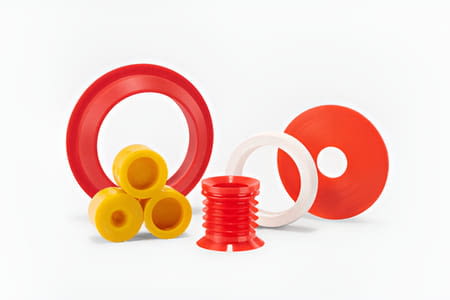
Plastic materials can be classified into three types according to their behaviour at high temperatures. Previously, we dedicated a post to the first two types: thermoplastics and thermosets. In today's post we will introduce the third type, elastomers. Each of these materials reacts differently when subjected to high temperatures. Once melted, thermoplastics can be remoulded and the process can be repeated. Thermosets are characterised by molecules that are permanently bonded and can therefore only be melted down once.
But what about elastomers? Let us explain!
But what about elastomers? Let us explain!
What is an elastomer?
An elastomer is a polymer with an elastic structure. In other words, it is a very flexible plastic material that, after coming into contact with heat deforms, but tends to return to its initial state, rarely melting. This is because the elastomer molecules align when the material is stretched, but regain their original shape when they are released.
There are two types of elastomers according to their behaviour at high temperatures, thermosetting elastomers (the most common) maintain their state and shape until they exceed the temperature limit and disintegrate. The other type of elastomers are thermoplastics, which deform when exposed to heat and can be easily moulded without losing their properties.
There are two types of elastomers according to their behaviour at high temperatures, thermosetting elastomers (the most common) maintain their state and shape until they exceed the temperature limit and disintegrate. The other type of elastomers are thermoplastics, which deform when exposed to heat and can be easily moulded without losing their properties.
Characteristics of elastomers
Some of the main plastic materials that can be classified as elastomers are: nitrile, silicone, polyurethane, Viton, neoprene, and rubber. Along with many types of synthetic rubbers, natural rubber is one of the most important plastics in the elastomer industry. It comes from a renewable source, has excellent elasticity and, thanks to its properties under dynamic loads, produces very little internal heat. In addition, it has high mechanical strength.
Elastomers in general, thanks to these elastic properties, boast great physical versatility and are easy to mould, handle and model into structures and shapes, and are a great asset to the manufacturing of industrial machinery parts. In addition, they also have chemical and thermal resistance, which makes them an excellent electrical insulator, and resistant to chemical components such as diluted acids and detergents.
In general, elastomers are highly durable plastics with excellent mechanical properties. They have many advantages for machine parts and machine guards as they are durable and increase the service life of the machinery. At Induplast, we manufacture parts such as: profiles, sealing gaskets, flat gaskets, stops, rollers and many more, for a wide variety of industries such as the food, chemical, medical or packaging industries among others.
Elastomers are also used for purposes such as cable sheathing, sealing, manufacturing of insulated suits, parts requiring thermal resistance and insulation, among others.
This is just a brief look at the most important properties of elastomers. If you need further information on any of these aspects, see the engineering plastics on our website, or contact us. We will be happy to help you.
Elastomers in general, thanks to these elastic properties, boast great physical versatility and are easy to mould, handle and model into structures and shapes, and are a great asset to the manufacturing of industrial machinery parts. In addition, they also have chemical and thermal resistance, which makes them an excellent electrical insulator, and resistant to chemical components such as diluted acids and detergents.
In general, elastomers are highly durable plastics with excellent mechanical properties. They have many advantages for machine parts and machine guards as they are durable and increase the service life of the machinery. At Induplast, we manufacture parts such as: profiles, sealing gaskets, flat gaskets, stops, rollers and many more, for a wide variety of industries such as the food, chemical, medical or packaging industries among others.
Elastomers are also used for purposes such as cable sheathing, sealing, manufacturing of insulated suits, parts requiring thermal resistance and insulation, among others.
This is just a brief look at the most important properties of elastomers. If you need further information on any of these aspects, see the engineering plastics on our website, or contact us. We will be happy to help you.







